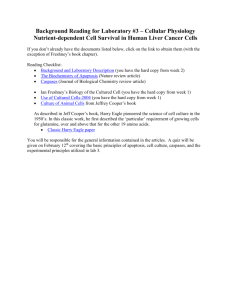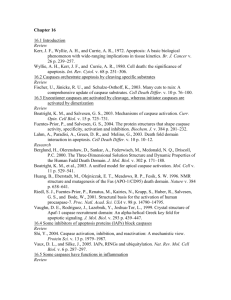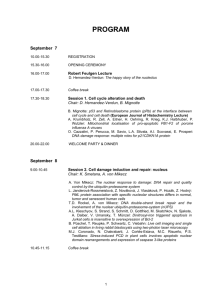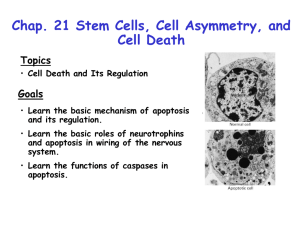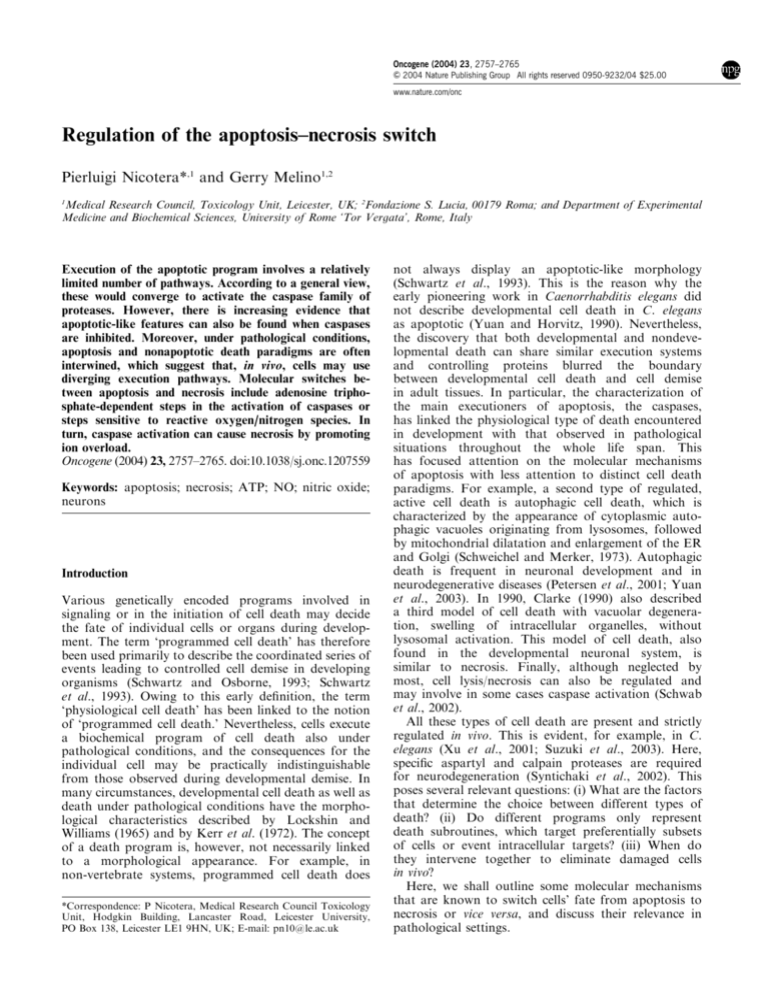
Oncogene (2004) 23, 2757–2765
& 2004 Nature Publishing Group All rights reserved 0950-9232/04 $25.00
www.nature.com/onc
Regulation of the apoptosis–necrosis switch
Pierluigi Nicotera*,1 and Gerry Melino1,2
1
Medical Research Council, Toxicology Unit, Leicester, UK; 2Fondazione S. Lucia, 00179 Roma; and Department of Experimental
Medicine and Biochemical Sciences, University of Rome ‘Tor Vergata’, Rome, Italy
Execution of the apoptotic program involves a relatively
limited number of pathways. According to a general view,
these would converge to activate the caspase family of
proteases. However, there is increasing evidence that
apoptotic-like features can also be found when caspases
are inhibited. Moreover, under pathological conditions,
apoptosis and nonapoptotic death paradigms are often
interwined, which suggest that, in vivo, cells may use
diverging execution pathways. Molecular switches between apoptosis and necrosis include adenosine triphosphate-dependent steps in the activation of caspases or
steps sensitive to reactive oxygen/nitrogen species. In
turn, caspase activation can cause necrosis by promoting
ion overload.
Oncogene (2004) 23, 2757–2765. doi:10.1038/sj.onc.1207559
Keywords: apoptosis; necrosis; ATP; NO; nitric oxide;
neurons
Introduction
Various genetically encoded programs involved in
signaling or in the initiation of cell death may decide
the fate of individual cells or organs during development. The term ‘programmed cell death’ has therefore
been used primarily to describe the coordinated series of
events leading to controlled cell demise in developing
organisms (Schwartz and Osborne, 1993; Schwartz
et al., 1993). Owing to this early definition, the term
‘physiological cell death’ has been linked to the notion
of ‘programmed cell death.’ Nevertheless, cells execute
a biochemical program of cell death also under
pathological conditions, and the consequences for the
individual cell may be practically indistinguishable
from those observed during developmental demise. In
many circumstances, developmental cell death as well as
death under pathological conditions have the morphological characteristics described by Lockshin and
Williams (1965) and by Kerr et al. (1972). The concept
of a death program is, however, not necessarily linked
to a morphological appearance. For example, in
non-vertebrate systems, programmed cell death does
*Correspondence: P Nicotera, Medical Research Council Toxicology
Unit, Hodgkin Building, Lancaster Road, Leicester University,
PO Box 138, Leicester LE1 9HN, UK; E-mail: pn10@le.ac.uk
not always display an apoptotic-like morphology
(Schwartz et al., 1993). This is the reason why the
early pioneering work in Caenorrhabditis elegans did
not describe developmental cell death in C. elegans
as apoptotic (Yuan and Horvitz, 1990). Nevertheless,
the discovery that both developmental and nondevelopmental death can share similar execution systems
and controlling proteins blurred the boundary
between developmental cell death and cell demise
in adult tissues. In particular, the characterization of
the main executioners of apoptosis, the caspases,
has linked the physiological type of death encountered
in development with that observed in pathological
situations throughout the whole life span. This
has focused attention on the molecular mechanisms
of apoptosis with less attention to distinct cell death
paradigms. For example, a second type of regulated,
active cell death is autophagic cell death, which is
characterized by the appearance of cytoplasmic autophagic vacuoles originating from lysosomes, followed
by mitochondrial dilatation and enlargement of the ER
and Golgi (Schweichel and Merker, 1973). Autophagic
death is frequent in neuronal development and in
neurodegenerative diseases (Petersen et al., 2001; Yuan
et al., 2003). In 1990, Clarke (1990) also described
a third model of cell death with vacuolar degeneration, swelling of intracellular organelles, without
lysosomal activation. This model of cell death, also
found in the developmental neuronal system, is
similar to necrosis. Finally, although neglected by
most, cell lysis/necrosis can also be regulated and
may involve in some cases caspase activation (Schwab
et al., 2002).
All these types of cell death are present and strictly
regulated in vivo. This is evident, for example, in C.
elegans (Xu et al., 2001; Suzuki et al., 2003). Here,
specific aspartyl and calpain proteases are required
for neurodegeneration (Syntichaki et al., 2002). This
poses several relevant questions: (i) What are the factors
that determine the choice between different types of
death? (ii) Do different programs only represent
death subroutines, which target preferentially subsets
of cells or event intracellular targets? (iii) When do
they intervene together to eliminate damaged cells
in vivo?
Here, we shall outline some molecular mechanisms
that are known to switch cells’ fate from apoptosis to
necrosis or vice versa, and discuss their relevance in
pathological settings.
Regulation of the apoptosis–necrosis switch
P Nicotera and G Melino
2758
Caspase-dependent cell death
The finding that one class of death-related genes, those
expressing caspases (cysteine aspartases) (Nicholson,
1999), are involved in cell death in genetically distant
organisms has directed attention on the central role of
this protease family as the main effector of apoptotic cell
demise. Consequently, there is a tendency to identify
apoptosis conceptually with its main execution system.
Caspases are constitutively expressed in mammals,
similar to ced-3 in C. elegans (Shaham and Horvitz,
1996). To date, at least 13 human caspases have been
identified. They are expressed as inactive proenzymes
and proteolytically activated to form active tetramers.
Substrates include cytoskeletal proteins, nuclear structural proteins and enzymes, and some controllers of
caspase activation (i.e. Bcl-2) (Nicholson, 1999). However, some caspases may eventually have death-unrelated, and perhaps vital functions and their activation
may not always underlie cell death. Caspase multiplicity
likely reflects their diverse roles under pathophysiological conditions. For example, caspases degrade amyloid
precursor protein, presenilins (PS1, PS2), tau, huntingtin, atrophin-1, ataxin-3 and the androgen receptor
(Ellerby et al., 1997; Gervais et al., 1999). However,
cleavage of relevant substrates does not necessarily
imply that caspase activation is the major mechanism
leading to cell death in pathological settings. It is indeed
unlikely that a single execution system, even as
diversified as the one involving caspases, is alone
responsible for death execution. Should this be the case,
viruses and transformed cells could have easily escaped
or shut down a program converging on a single
execution pathway. These considerations may help to
understand why different sets of caspases are recruited
in different paradigms of mammalian cell death, and
also why deletion of single caspases has only localized
and partial effects on cell death (Kuida et al., 1996,
1998). Moreover, several forms of demise seem to be
caspase independent (Sarin et al., 1997) or even
accelerated by caspase inhibitors (Vercammen et al.,
1998a, b). Indeed, other protease families have been
implicated in apoptosis (Adjei et al., 1996; Grimm et al.,
1996), while caspases can be activated without causing
cell death (Jaattela et al., 1998). In some cases, caspase
inhibition does not alter the extent of death, but rather
the shape of demise (Hirsch et al., 1997; Leist et al.,
1997).
The degree of caspase activation may also be of
importance. Caspase activation varies quantitatively
from system to system, and it is unclear whether a
threshold has to be reached to turn caspase activation
into a lethal reaction. For example, a moderate degree
of caspase activation does not always cause cell demise
(Jaattela et al., 1998). Finally, an apoptotic-like death
can also occur in a caspase-independent manner (see, for
review, Borner and Monney, 1999). Part of the problem
may be due to the fact that caspase inhibitors can
prevent the appearance of certain, but not all, features
of apoptosis in certain model systems (McCarthy et al.,
1997). In this context, caution should be exercised,
Oncogene
because of possible nonspecific effects of broad-range
caspase inhibitors. Although generally considered specific for the caspase family, these inhibitory peptides
may in fact block only some, but not all, caspases. It is
also clear that caspase inhibitors can also inhibit
unrelated proteases, whose activity may be necessary
for survival. While the existence of alternative pathways
may be conceivable, to date, the evidence for effective
alternative execution systems is limited. The crosstalk
between caspases and other proteases is also worth
considering in this context. In particular, calpains, and
also other proteases can synergize or in contrast hinder
caspases in the execution of cell death. Notably, recent
work suggests that caspases can also trigger secondary
necrosis when they cleave and inactivate plasma
membrane Ca2 þ transport systems. This causes secondary Ca2 þ overload and plasma membrane lysis (Schwab
et al., 2002).
Energy requirement for the shape of cell death
While the occurrence of a caspase-independent apoptosis is strongly debated, it is instead widely accepted that,
in some cases, caspase inhibitors only delay cell demise.
Cells die eventually with morphologically different
characteristics (Hirsch et al., 1997; Leist et al., 1997).
Evidence that cells triggered to undergo apoptosis are
instead forced to die by necrosis when energy levels are
rapidly compromised has been recently provided (Leist
et al., 1997), see Figure 1.
In vivo, under pathological conditions, apoptosis and
necrosis may often coexist (Leist et al., 1995). Moreover,
Figure 1 Apoptosis–necrosis switch by ATP. Switch of the
morphology of cell death, shown by electron microscopy, and its
regulation by the intracellular ATP concentration levels
Regulation of the apoptosis–necrosis switch
P Nicotera and G Melino
2759
intracellular energy levels are rapidly dissipated in
necrosis, but not in apoptosis (Ankarcrona et al., 1994).
By manipulating the intracellular adenosine
triphosphate (ATP) level, it has been possible to
determine that when intracellular ATP is low, typical
apoptotic stimuli cause necrosis (Leist et al., 1997).
ATP can be either depleted or repleted to defined levels
and for defined periods of time. This allows identification of a defined period of time after the exposure
of cells to apoptogenic stimuli during which energydependent steps are required to complete the apoptotic program. If ATP concentrations are markedly
reduced during this period, activation of downstream caspases and all typical apoptotic features are
blocked. Stimulated cells die nonetheless. However,
death has a necrotic appearance. These findings provide
direct evidence that the complete apoptotic program
involves energy-requiring steps, one of which is at
the level of the formation of the protein complex
between Apaf-1, cytochrome c (cyt c) and procaspases
(Liu and Stamler, 1999), outlined in Figure 2. Lack of
ATP at this step would prevent the resulting
downstream degradative processes including caspase-3
activation.
Nitric oxide (NO) as an inhibitor or activator of apoptosis
and molecular switch between apoptosis and necrosis
NO is a second messenger molecule with the unique
property, being a gas, of freely moving from one cell to
the other (Moncada et al., 1991; Bredt and Snyder,
1994). In fact, NO is an extremely versatile messenger in
biological systems, and has been implicated in a number
of different physiopathological roles, such as smooth
muscle relaxation, platelet inhibition, neurotransmission, immune regulation, cell differentiation and tissue
morphogenesis (Stamler and Piantadosi, 1996; Stamler
et al., 1997; Brune et al., 1999; Nicotera et al., 1999a; Gu
et al., 2002) and cytotoxicity (Brune et al., 1999). Cell
Figure 2 ATP-dependent steps in apoptosis. Potential regulation
of the cell death machinery by ATP
death elicited by endogenously derived NO plays a
central role in pathologic phenomena such as septic
shock, nonspecific ‘host’ defense against tumors and
intracellular pathogens, acute and chronic neurodegenerative diseases, pancreatic b-cell destruction in diabetes
mellitus and transplant rejection (Choi, 1988; Moncada
et al., 1991; Bredt and Snyder, 1994; Kaneto et al., 1995;
Bonfoco et al., 1996; Nicotera et al., 1997, 1999b; Leist
and Nicotera, 1998). Figure 3 shows a schematic pattern
of the action of NO, from its synthesis, chemical
interactions, intracellular biochemical effectors, leading
to its biological actions.
NO is a hydrophobic molecule and a highly diffusible
free radical, generated from the oxidation of L-arginine
to L-citrulline by a family of constitutive or cytokineinducible nictotinamide adenine dinucleotide phosphate-dependent isoenzymes, the NO synthases (NOS)
(part 2 in Figure 3). Neuronal NOS (nNOS) and
endothelial NOS (eNOS) are usually constitutively
expressed in selective tissues, and are transiently
activated by an increase in intracellular concentration
of free Ca2 þ . On the contrary, the cytokine-inducible
NOS (iNOS) is transcriptionally regulated, resulting in
NO production at basal Ca2 þ levels for up to several
days (Nicotera et al., 1999a). Following its production,
NO is preserved in its molecular structure by a
chemically heterogeneous group of spontaneously decomposing NO donors (part 3 in Figure 3). This deposit
stabilization finely tunes the biological activity of NO
after its liberation.
NO is highly reactive (see part 3 in Figure 3), and
its half-life is extremely short in biological systems,
being estimated below microseconds. The chemistry
of NO involves inter-related redox forms (NO, NO þ ,
NO), with different chemical reactivity toward distinct
target groups, thus explaining the pleiotropic effects of
NO in biological systems (see Figure 3) (Stamler et al.,
1992a, b). NO reacts with molecular oxygen, superoxide
anion and transition metal cations, leading to the
formation of reactive nitrogen intermediates that
Figure 3 Generation, storage, reactivity and activity of nitric
oxide. Regulation (1), synthesis (2), molecular interactions (3),
activity on effectors (4) and the biological effects (5) of NO are
indicated in a simplified scheme. See text for details
Oncogene
Regulation of the apoptosis–necrosis switch
P Nicotera and G Melino
2760
directly or indirectly support additional nitrosative
reactions (Figure 3). In particular, NO binds to
hemoproteins and iron–sulfur centers. The nitrosonium
cation (NO þ ) character found in nitroso compounds in
biological systems is involved in nitrosation reactions
with nucleophilic groups such as thiols, amines,
carboxyls, hydroxyls, and aromatic rings (Figure 3).
The nitroxyl anion (NO) rapidly undergoes dimerization and dehydration, thus generating dinitrogen oxide,
in addition to reacting with thiols leading to sulfhydryl
oxidation and with metals (Figure 3).
NO-mediated intracellular signaling pathways can be
mediate by cyclic guanylic acid (cGMP) (Figure 3);
cGMP formation results from NO binding to the heme
group of soluble guanylyl cyclase, thus leading to
enzyme activation. Alternatively, cGMP-independent
mechanisms include inhibition of iron–sulfur centers,
DNA damage, poly(adenosine 5%-diphosphate-ribosylation) activation with cellular energy deprivation
and protein modification due to S-nitrosylation of
thiol groups, thiol oxidation to sulfenic and sulfinic
acid and tyrosine nitration (Stamler, 1994; Becker
et al., 1998; Stamler and Hausladen, 1998; Foster et al.,
2003). cGMP-independent NO-induced responses account for the antimicrobial, cytostatic and cytotoxic
ability of NO. S-nitrosylation of cysteine residues is a
common protein modification achieved by NO in the
presence of oxygen and is usually associated with
the loss of protein function (Hess et al., 2001;
Matsumoto et al., 2003).
S-nitrosylation may regulate cellular signal transduction by influencing signaling proteins such as p21ras
(Lander et al., 1995) and c-Jun N-terminal kinase 2 (So
et al., 1998). It affects the cellular gene transcription
machinery by inhibiting the DNA-binding activity of
nuclear factor kB (NF-kB) (Matthews et al., 1996;
Marshall and Stamler, 2001) and activator protein-1
(AP-1) (Tabuchi et al., 1994) or by activation of OxyR
(Hausladen et al., 1996). NO nitrosylates thiol groups of
cytosolic enzymes such as transglutaminase (Melino
et al., 1997; Bernassola et al., 1999; Rossi et al., 2000),
AP-1 (Bernassola et al., 2001; Melino et al., 2000a),
caspases (Dimmeler et al., 1997; Melino et al., 1997),
glyceraldehyde-3-phosphate dehydrogenase (Mohr et al.,
1996) hemoglobin (Jia et al., 1996; Gow and Stamler,
1998) and skeletal muscle (Stamler and Meissner, 2001;
Eu et al., 2003), and it can modulate the biological
activity of extracellular molecules such as coagulation
factor XIII (Catani et al., 1998).
In addition to regulating directly the ‘apoptotic’
machinery, see Figure 4, NO finely regulates the NMDA
receptors, and therefore excitotoxicity in neuronal cells
(Lipton et al., 1993), including neuroblastoma cells
exposed to the gp120 HIV protein (Corasaniti et al.,
1992, 1994, 1995; Bagetta et al., 1993; Clementi et al.,
1996; Maccarrone et al., 2000), or even tamoxifen
(Maccarrone et al., 1998) or fenretinide (Lovat et al.,
2003). Via S-nitrosylation or nitration of proteins, NO
can be a bifunctional modulator of cell death capable of
either triggering or inhibiting cell demise. In addition,
NO can regulate the apoptosis–necrosis switch.
Oncogene
Figure 4 Interaction of NO with the apoptotic molecular
machinery. NO has been shown to interact and regulate different
steps in the apoptotic pathway: death receptor signaling, mitochondrial sensitivity, transcription factors and caspase activation.
This regulation is able to alter the sensitivity of the cell to die
Mechanisms of NO inhibition of cell death
S-nitrosylation
NO can inhibit apoptosis. Figure 4 shows the ability of
NO donors to inhibit receptor-mediated cell death. This
was first demonstrated in neuronal cells during excitotoxicity (Lipton et al., 1993). NO can also inhibit cell
death in endothelial cells (Dimmeler et al., 1997) and in
lymphoid cells (Mannick et al., 1994; Melino et al.,
1997). S-nitrosylation of several critical factors may be
important for cell survival. S-nitrosylation of the Nmethyl-D-aspartate receptor reduces neuronal demise
due to excitotoxicity (Lipton et al., 1993; Kim et al.,
1999; Lipton, 1999; Bossy-Wetzel and Lipton, 2003;
Manabe and Lipton, 2003). The apoptosis execution
pathway can also be interrupted by NO at different
steps. Figure 4 shows several protein targets of the
apoptotic machinery, which can be inhibited by NO
through direct S-nitrosylation of catalytic cysteine
residues. NO may interfere with the downstream
apoptotic machinery acting either at the level of the
executioner caspases or upstream of these events to
inhibit initiator caspases such as caspase-8 and transcriptional factors such as AP-1 and NF-kB. The action
of NO could therefore differ in distinct cells, depending
on the specific pathway activated.
For example, exogenous NO can inhibit CD95
signaling in Jurkat T or endothelial cells via Snitrosylation of caspase-3-like proteases (Melino et al.,
1997). Other studies have shown NO-mediated inactivation of caspases in apoptotic models such as CD95ligated human leukocytes (Mannick et al., 1997;
Mannick et al., 1999) and tumor necrosis factor a
(TNFa)-, proatherosclerotic factor-, and reactive oxygen species (ROS)-stimulated rat hepatocytes and
endothelial cell lines (Kim et al., 1997a; Dimmeler and
Zeiher, 1999; Li and Billiar, 1999). The effects of NO
can directly inhibit caspase activity by S-nitrosylation of
the active-site cysteine residue (Li et al., 1997; Melino
et al., 1997). NO is also able to suppress a mechanism
for the initiation or amplification of apoptotic signaling.
Kim et al. (1998) have reported that both Bcl-2 cleavage
and cyt c release are inhibited in TNFa- and actinomy-
Regulation of the apoptosis–necrosis switch
P Nicotera and G Melino
2761
cin D-treated MCF-7 adenocarcinoma cells exposed to
NO donors. Finally, NO can deplete mitochondrial
ATP generation and thereby switch apoptosis into
necrosis (see below). Interestingly, caspase zymogens
are endogenously S-nitrosylated in nonstimulated human lymphocyte cell lines, and CD95 ligation can
activate caspase-3 also by stimulating the denitrosylation of its catalytic site cysteine (Liu and Stamler, 1999;
Mannick et al., 1999).
NO as a scavenger of radical species
NO can be protective against cellular damage resulting
from cerebral and myocardial ischemia : reperfusion.
NO exerts this protective action through the reaction
with alkoxyl and peroxyl radicals, thus inhibiting lipid
peroxidation (Rubbo et al., 1994); it also suppresses the
superoxide : hydrogen peroxide-mediated cytotoxic effect by acting as a scavenger of ROS (Wink et al., 1993;
Brune et al., 1997; Enikolopov et al., 1999).
Induction of cell death by NO
While the reactions described above can inhibit the
execution of cell death, NO can also cause cell death. NO
is implicated in both apoptotic and necrotic cell death
depending on the NO chemistry and the cellular
biological redox state. Also, exposure to different levels
of NO can produce different outcomes: high NO levels in
neurons trigger necrosis, while longer exposure to lower
NO concentrations can trigger apoptosis (Bonfoco et al.,
1995), see Figure 4a. The reactivity of NO, Figure 1, is
the key to understanding when and how NO causes
death or survival, Figure 4b, but its intrinsic complexity
makes it difficult to pinpoint a specific chemical species
(NO, NO þ , NO), with a direct biochemical reaction (Snitrosylation, ROS reactions, Fe–heme binding, mitochondrial DF and ATP regulation) and the biological
effect (survival, apoptosis, necrosis).
NO-induced apoptosis
Induction of protective proteins
Exogenous NO or preinduction of iNOS has been
shown to stimulate the expression of the inducible heatshock protein 70 (Hsp70) and subsequently prevent
hepatocytes from TNFa- and actinomycin D-induced
apoptosis (Kim et al., 1997a). Even though it has been
recently suggested that Hsp70 acts downstream of
caspase activation (Jaattela et al., 1998), the mechanisms
through which it suppresses apoptosis remain largely
unknown. NO can also inhibit cell death by inducing the
expression of other protective proteins such as cyclooxygenase-2 (Brune et al., 1999), hemeoxygenase-1 (Kim
et al., 1995) and metallothionein (Schwarz et al., 1995).
Recent studies have demonstrated that protection from
ultraviolet-A-induced apoptosis is strongly correlated
with NO-elicited upregulation of Bcl-2 expression
(Suschek et al., 1999).
cGMP-dependent mechanisms
In hepatocytes, NO prevents increases in caspase
activity by a cGMP-dependent mechanism that does
not involve S-nitrosylation (Kim et al., 1997b; Li and
Billiar, 1999). Furthermore, eNOS activation, which
exerts a protective effect on the susceptibility of
activated T-lymphocytes to CD95-triggered apoptosis,
acts via cGMP-dependent pathways (Sciorati et al.,
1997). The effect of cGMP on apoptosis seems to be
mediated through cGMP-dependent kinase (Kim et al.,
1997b).
Inhibition of ANT
NO can directly regulate the activity of the ANT
mitochondrial protein, crucial for the activation of
mitochondrial depolarization in certain apoptosis models (Vieira et al., 2001). Therefore, NO can directly
regulate the threshold of release of mitochondrial
proteins such as cyt c, AIF, Omi/HtrA2 and Diablo/
Smac, thus finely tuning apoptosis.
NO induces apoptosis in a variety of cell types, including
macrophages (Brune et al., 1999), neurons (Bonfoco
et al., 1995), pancreatic b cells (Ankarcrona et al., 1994;
Kaneto et al., 1995), thymocytes (Fehsel et al., 1995),
chondrocytes (Blanco et al., 1995) and hepatocytes
(Leist et al., 1995). The signaling pathways that lead to
apoptosis still remain poorly understood. NO-induced
apoptosis is often accompanied by accumulation of the
tumor suppressor gene p53, changes in the expression of
pro- and antiapoptotic Bcl-2 family members, caspase-3like protease activation and cyt c translocation (Brune
et al., 1999). This is mediated by a chemical interaction
with mdm2, which fails to degrade and inactivate p53
(Wang et al., 2002, 2003; Schneiderhan et al., 2003). In
the excitotoxic death of cultured neurons, NO-triggered
apoptosis requires a Ca2 þ signal triggered by the
activation of the NMDAR channels (Bonfoco et al.,
1996). Depletion of ATP in PC12 cells, caused via the
NO-mediated inhibition of the glycolytic enzyme
glyceraldehyde-3-phosphate dehydrogenase, is one of
the mechanisms responsible for NO neurotoxicity
(Yasuda et al., 1998). However, the NO-mediated
modification glyceraldehyde-3-phosphate dehydrogenase modification cannot necessarily be linked to energy
depletion, at least in monocytic macrophage cell lines
(Messmer and Brune, 1996).
Mechanisms of NO-mediated necrosis
NO induces necrosis in several cell systems via multiple
target interactions, with thiol groups, heme, iron–sulfur
and tyrosine residues containing proteins and DNA, and
have been implicated in NO-mediated necrosis (Figure
5a and b). Some of these effects may be direct, whereas
others may arise from the reaction of NO with superoxide anion and, at high concentrations, with oxygen to
form peroxynitrite (ONOO) and nitrosative agents,
respectively. As stated above, NO high concentrations
or short time inhibit essential cellular processes, such as
DNA synthesis, mitochondrial respiration and metabolic
Oncogene
Regulation of the apoptosis–necrosis switch
P Nicotera and G Melino
2762
Figure 5 Apoptosis–necrosis switch by NO. The intensity of the
stimulus and the time of exposure affect the type of cell death
induced (a), via interaction with several molecular targets (b and
also Figure 4), which can also result in the complete inhibition of
death (b). Depending on the site and on the type of interaction, the
action of NO can indeed result in the induction of apoptosis (c), in
the inhibition of cell death (d), as well as in the induction of
necrosis (e), when the insult is not compatible with life and the cell
death machinery is inhibited. The intracellular redox status and the
redox defenses of the cell finely regulate the biological effect of NO
reactions (Figure 4 and 5). Thus, NO reacts with
ribonucleotide reductase, targeting both thiol groups
and the tyrosyl-free radical required for catalysis,
inhibiting deoxyribonucleotide synthesis (Roy et al.,
1995). NO can disrupt mitochondrial function by
reversibly inactivating cyt c oxidase, thus stimulating
superoxide anion production by the respiratory chain
(Cleeter et al., 1994). The resulting superoxide anion,
through the formation of ONOO, irreversibly inhibits
complexes I and III of the mitochondrial electron
transport chain (Bolanos et al., 1995). It also inactivates
crucial metabolic enzymes such as aconitase, by forming
iron–nitrosyl complexes with its Fe-S centers. Even
though inhibition of aconitase does not necessarily induce
ATP depletion depending on the cell model, it may lead
to a reduction in glucose and amino-acid metabolism and
subsequent energy loss (Welsh et al., 1991).
NO therefore seems to kill via ONOO-mediated
pathways. ONOO causes lipid peroxidation (Radi et al.,
1991), chemical cleavage of DNA (Salgo et al., 1995)
and nitration of both free and protein-bound tyrosine
with subsequent alterations of protein phosphorylation
or perturbation of protein tertiary structure. ONOO
seems to contribute to cell death through the activation
of the nuclear enzyme poly(adenosine 5%-diphosphoribose) synthetase, which in turn results in ATP depletion
(Zhang et al., 1994). It is not clear as to whether this is
the primary mechanism of NO-induced necrosis.
NO shifts the apoptotic response elicited by different
stimuli into necrotic cell death
The combined exposure of Jurkat T cells to an agonist
anti-CD95 antibody and increasing concentrations of
Oncogene
SNAP prevent apoptosis (Melino et al., 1997). Inhibition of apoptosis and the shift to necrosis in Jurkat
(Leist et al., 1999) and neuronal cells (Volbracht et al.,
2001) can occur by NO-mediated ATP depletion or by
directly preventing caspases activation (Melino et al.,
1997). It is evident from these results that NO can
control the switch from apoptosis into necrosis.
In neuronal apoptosis, NO can have unique features.
While it can trigger glutamate release and excitotoxic
cell death, NO can also prevent caspases activation and
switch cell death from apoptosis into necrosis. This may
be relevant in neurodegeneration when a persistent
proinflammatory condition may cause sustained generation of NO. Neurons exposed to a microtubuledisassembling agent, colchicine die by apoptosis (Volbracht et al., 1999). However, if ATP is depleted by NO,
cell death occurs by necrosis. ATP depletion prevents in
this system both the activation of caspases and the
exposure of phagocytosis-recognition molecules.
Conclusions
It is perhaps not surprising that initially simple death
programs, developed early during phylogeny, undergo
complex modifications in mammalian cells. Large gene
families have evolved to provide a more intricate control
of cell death in higher organisms, in part, perhaps to
accommodate the need of individual organ differentiation. A consequence of the increased complexity may be
that an increasing number of feedback loops gives rise to
multiple possibilities of initiation, control and execution.
The main implication of this standpoint is the exclusion
of a single, predominant commitment step. It seems
likely that accumulation of damage incompatible with
cell survival would require disruption of several vital cell
functions. Once such a threshold is trespassed, multiple
positive feedback loops would ensure the progression of
Figure 6 Signaling versus toxic effects of NO. NO can react with
different chemical groups resulting in reversible or irreversible
reactions. These can be simplified as a progressive scale of
modification. Stamler (Stamler, 1994; Stamler and Hausladen,
1998; Stamler et al., 2001, 1992a, b, 1997; Stamler and Piantadosi,
1996; )proposed that while reversible reactions are related to
signaling, therefore to the life of the cell, irreversible reactions
result in toxic effects. These chemical mechanisms are responsible
for the biological effects outlined in Figure 5
Regulation of the apoptosis–necrosis switch
P Nicotera and G Melino
2763
the death program to the end, and the safe disposal of
the injured cell. This also implies that the morphological
appearance of cell death (apoptosis or necrosis) is not
linked to a single commitment point, but rather is a
result of a more or less complete execution of
subroutines deciding on the shape of dying cells.
Physiological mediators such as NO have emerged as
potent modulators of death pathways (Melino et al.,
1997, 2000b; Brune et al., 1999; Li and Billiar, 1999;
Nicotera et al., 1999a) and may act as effective switches
between cell death paradigms in vivo. The ability of
NO to diffuse intracellularly rapidly and from cell to
cell would represent an efficient mechanism to prevent
the activation of apoptotic effector molecules such
as caspases, resulting from cell injury or exposure to
other activators (CD95L, TNFa, ceramides, retinoids,
chemotherapeutic drugs). Alternatively, the ability of
NO to prevent apoptosis may decide the degree of
inflammation in pathological states. Finally, NO can
induce cell death depending on the biological milieu, its
redox state, concentration, exposure time and the
combination with oxygen, superoxide and other molecules. One way to look at the pathophysiologically
relevant switches between apoptosis and necrosis has
been suggested by Stamler (Stamler et al., 1992a, b,
1997, 2001; Stamler, 1994; Stamler and Piantadosi,
1996; Stamler and Hausladen, 1998), who conceptually
separate reversible NO reactions, involved in signaling,
from nonreversible NO reactions, involved in toxicity
(Figure 6). Regardless of the mediator or tissue
condition that may decide the switch between different
cell death modes, it is apparent that targeting individual
death routines may not be sufficient to ameliorate
disease states effectively.
Acknowledgements
The work was supported by the Medical Research Council,
and by grants from Telethon (E1224), AIRC, EU (QLG11999-00739 and QLK-CT-2002-01956), MIUR, MinSan to
GM.
References
Adjei PN, Kaufmann SH, Leung W-Y, Mao F and Gores GJ.
(1996). J. Clin. Invest., 98, 2588–2596.
Ankarcrona M, Dypbukt JM, Brune B and Nicotera P. (1994).
Exp. Cell Res., 213, 172–177.
Bagetta G, Corasaniti MT, Melino G, Paoletti AM, FinazziAgro A and Nistico G. (1993). Biochem. Biophys. Res.
Commun., 197, 1132–1139.
Becker K, Savvides SN, Keese M, Schirmer RH and Karplus
PA. (1998). Nat. Struct. Biol., 5, 267–271.
Bernassola F, Catani MV, Corazzari M, Rossi A and Melino
G. (2001). J. Cell. Biochem., 82, 123–133.
Bernassola F, Rossi A and Melino G. (1999). Ann. NY Acad.
Sci., 887, 83–91.
Blanco FJ, Ochs RL, Schwarz H and Lotz M. (1995). Am.
J. Pathol., 146, 75–85.
Bolanos JP, Heales SJ, Land JM and Clark JB. (1995).
J. Neurochem., 64, 1965–1972.
Bonfoco E, Krainc D, Ankarcrona M, Nicotera P and Lipton
SA. (1995). Proc. Natl. Acad. Sci. USA, 92, 7162–7166.
Bonfoco E, Leist M, Zhivotovsky B, Orrenius S, Lipton SA
and Nicotera P. (1996). J. Neurochem., 67, 2484–2493.
Borner C and Monney L. (1999). Cell Death Differ., 6, 497–507.
Bossy-Wetzel E and Lipton SA. (2003). Cell Death Differ., 10,
757–760.
Bredt DS and Snyder SH. (1994). Annu. Rev. Biochem., 63,
175–195.
Brune B, Gotz C, Messmer UK, Sandau K, Hirvonen MR and
Lapetina EG. (1997). J. Biol. Chem., 272, 7253–7258.
Brune B, von Knethen A and Sandau KB. (1999). Cell Death
Differ., 6, 969–975.
Catani MV, Bernassola F, Rossi A and Melino G. (1998).
Biochem. Biophys. Res. Commun., 249, 275–278.
Choi DW. (1988). Neuron, 1, 623–634.
Clarke PG. (1990). Anat. Embryol. (Berl.), 181, 195–213.
Cleeter MW, Cooper JM, Darley-Usmar VM, Moncada S and
Schapira AH. (1994). FEBS Lett., 345, 50–54.
Clementi E, Racchetti G, Melino G and Meldolesi J. (1996).
Life Sci., 59, 389–397.
Corasaniti MT, Melino G, Navarra M, Garaci E,
Finazzi-Agro A and Nistico G. (1995). Neurodegeneration,
4, 315–321.
Corasaniti MT, Melino G, Tartaglia RL, Finazzi-Agro
A and Nistico G. (1994). Neuropharmacology, 33,
1071–1077.
Corasaniti MT, Tartaglia RL, Melino G, Nistico G and
Finazzi-Agro A. (1992). Neurosci. Lett., 147, 221–223.
Dimmeler S, Haendeler J, Nehls M and Zeiher AM. (1997).
J. Exp. Med., 185, 601–607.
Dimmeler S and Zeiher AM. (1999). Cell Death Differ., 6,
964–968.
Ellerby HM, Martin SJ, Ellerby LM, Naiem SS, Rabizadeh S,
Salvesen GS, Casiano CA, Cashman NR, Green DR and
Bredesen DE. (1997). J. Neurosci., 17, 6165–6178.
Enikolopov G, Banerji J and Kuzin B. (1999). Cell Death
Differ., 6, 956–963.
Eu JP, Hare JM, Hess DT, Skaf M, Sun J, Cardenas-Navina I,
Sun QA, Dewhirst M, Meissner G and Stamler JS. (2003).
Proc. Natl. Acad. Sci. USA, 100, 15229–15234.
Fehsel K, Kroncke KD, Meyer KL, Huber H, Wahn V and
Kolb-Bachofen V. (1995). J. Immunol., 155, 2858–2865.
Foster MW, McMahon TJ and Stamler JS. (2003). Trends
Mol. Med., 9, 160–168.
Gervais FG, Xu D, Robertson GS, Vaillancourt JP, Zhu Y,
Huang J, LeBlanc A, Smith D, Rigby M, Shearman MS,
Clarke EE, Zheng H, Van Der Ploeg LH, Ruffolo SC,
Thornberry NA, Xanthoudakis S, Zamboni RJ, Roy S and
Nicholson DW. (1999). Cell, 97, 395–406.
Gow AJ and Stamler JS. (1998). Nature, 391, 169–173.
Grimm LM, Goldberg AL, Poirier GG, Schwartz LM and
Osborne BA. (1996). EMBO J., 15, 3835–3844.
Gu Z, Kaul M, Yan B, Kridel SJ, Cui J, Strongin A, Smith
JW, Liddington RC and Lipton SA. (2002). Science, 297,
1186–1190.
Hausladen A, Privalle CT, Keng T, DeAngelo J and Stamler
JS. (1996). Cell, 86, 719–729.
Hess DT, Matsumoto A, Nudelman R and Stamler JS. (2001).
Nat. Cell Biol., 3, E46–9.
Hirsch T, Marchetti P, Susin SA, Dallaporta B, Zamzami N,
Marzo I, Geuskens M and Kroemer G. (1997). Oncogene,
15, 1573–1581.
Jaattela M, Wissing D, Kokholm K, Kallunki T and Egeblad
M. (1998). EMBO J., 17, 6124–6134.
Oncogene
Regulation of the apoptosis–necrosis switch
P Nicotera and G Melino
2764
Jia L, Bonaventura C, Bonaventura J and Stamler JS. (1996).
Nature, 380, 221–226.
Kaneto H, Fujii J, Seo HG, Suzuki K, Matsuoka T,
Nakamura M, Tatsumi H, Yamasaki Y, Kamada T and
Taniguchi N. (1995). Diabetes, 44, 733–738.
Kerr JF, Wyllie AH and Currie AR. (1972). Br. J. Cancer, 26,
239–257.
Kim YM, Bergonia HA, Muller C, Pitt BR, Watkins WD and
Lancaster Jr JR. (1995). J. Biol. Chem., 270, 5710–5713.
Kim WK, Choi YB, Rayudu PV, Das P, Asaad W,
Arnelle DR, Stamler JS and Lipton SA. (1999). Neuron,
24, 461–469.
Kim YM, de Vera ME, Watkins SC and Billiar TR. (1997a).
J. Biol. Chem., 272, 1402–1411.
Kim YM, Kim TH, Seol DW, Talanian RV and Billiar TR.
(1998). J. Biol. Chem., 273, 31437–31441.
Kim YM, Talanian RV and Billiar TR. (1997b). J. Biol.
Chem., 272, 31138–31148.
Kuida K, Haydar TF, Kuan C-Y, Gu Y, Taya C, Karasuyama
H, Su MS-S, Rakic P and Flavell RA. (1998). Cell, 94,
325–337.
Kuida K, Zheng TS, Na S, Kuan C, Yang D, Karasuyama H,
Rakic P and Flavell RA. (1996). Nature, 384, 368–372.
Lander HM, Ogiste JS, Pearce SF, Levi R and Novogrodsky
A. (1995). J. Biol. Chem., 270, 7017–7020.
Leist M, Gantner F, Jilg S and Wendel A. (1995). J. Immunol.,
154, 1307–1316.
Leist M and Nicotera P. (1998). Exp. Cell Res., 239, 183–201.
Leist M, Single B, Castoldi AF, Kuhnle S and Nicotera P.
(1997). J. Exp. Med., 185, 1481–1486.
Leist M, Single B, Naumann H, Fava E, Simon B, Kuhnle S
and Nicotera P. (1999). Exp. Cell Res., 249, 396–403.
Li J and Billiar TR. (1999). Cell Death Differ., 6, 952–955.
Li J, Billiar TR, Talanian RV and Kim YM. (1997). Biochem.
Biophys. Res. Commun., 240, 419–424.
Lipton SA. (1999). Cell Death Differ., 6, 943–951.
Lipton SA, Choi YB, Pan ZH, Lei SZ, Chen HS, Sucher NJ,
Loscalzo J, Singel DJ and Stamler JS. (1993). Nature, 364,
626–632.
Liu L and Stamler JS. (1999). Cell Death Differ., 6, 937–942.
Lockshin RA and Williams CM. (1965). J. Insect Physiol., 11,
123–133.
Lovat PE, Ranalli M, Corazzari M, Raffaghello L, Pearson
AD, Ponzoni M, Piacentini M, Melino G and Redfern CP.
(2003). J. Cell. Biochem., 89, 698–708.
Maccarrone M, Fantini C, Ranalli M, Melino G and Agro
AF. (1998). FEBS Lett., 434, 421–424.
Maccarrone M, Lorenzon T, Bari M, Melino G and FinazziAgro A. (2000). J. Biol. Chem., 275, 31938–31945.
Manabe S and Lipton SA. (2003). Invest. Ophthalmol. Vis.
Sci., 44, 385–392.
Mannick JB, Asano K, Izumi K, Kieff E and Stamler JS.
(1994). Cell, 79, 1137–1146.
Mannick JB, Hausladen A, Liu L, Hess DT, Zeng M, Miao
QX, Kane LS, Gow AJ and Stamler JS. (1999). Science, 284,
651–654.
Mannick JB, Miao XQ and Stamler JS. (1997). J. Biol. Chem.,
272, 24125–24128.
Marshall HE and Stamler JS. (2001). Biochemistry, 40, 1688–
1693.
Matsumoto A, Comatas KE, Liu L and Stamler JS. (2003).
Science, 301, 657–661.
Matthews JR, Botting CH, Panico M, Morris HR and Hay
RT. (1996). Nucleic Acids Res., 24, 2236–2242.
McCarthy NJ, Whyte MK, Gilbert CS and Evan GI. (1997).
J. Cell Biol., 136, 215–227.
Oncogene
Melino G, Bernassola F, Catani MV, Rossi A, Corazzari M,
Sabatini S, Vilbois F and Green DR. (2000a). Cancer Res.,
60, 2377–2383.
Melino G, Bernassola F, Knight RA, Corasaniti MT, Nistico
G and Finazzi-Agro A. (1997). Nature, 388, 432–433.
Melino G, Catani MV, Corazzari M, Guerrieri P and
Bernassola F. (2000b). Cell. Mol. Life Sci., 57, 612–622.
Messmer UK and Brune B. (1996). Eur J. Pharmacol., 302,
171–182.
Mohr S, Stamler JS and Brune B. (1996). J. Biol. Chem., 271,
4209–4214.
Moncada S, Palmer RM and Higgs EA. (1991). Pharmacol.
Rev., 43, 109–142.
Nicholson DW. (1999). Cell Death Differ., 6, 1028–1042.
Nicotera P, Ankarcrona M, Bonfoco E, Orrenius S and Lipton
SA. (1997). Adv. Neurol., 72, 95–101.
Nicotera P, Bernassola F and Melino G. (1999a). Cell Death
Differ., 6, 931–933.
Nicotera P, Leist M and Manzo L. (1999b). Trends Pharmacol.
Sci., 20, 46–51.
Petersen A, Larsen KE, Behr GG, Romero N, Przedborski S,
Brundin P and Sulzer D. (2001). Hum. Mol. Genet., 10,
1243–1254.
Radi R, Beckman JS, Bush KM and Freeman BA. (1991).
Arch. Biochem. Biophys., 288, 481–487.
Rossi A, Catani MV, Candi E, Bernassola F, Puddu P and
Melino G. (2000). J. Invest. Dermatol., 115, 731–739.
Roy B, Lepoivre M, Henry Y and Fontecave M. (1995).
Biochemistry, 34, 5411–5418.
Rubbo H, Radi R, Trujillo M, Telleri R, Kalyanaraman B,
Barnes S, Kirk M and Freeman BA. (1994). J. Biol. Chem.,
269, 26066–26075.
Salgo MG, Bermudez E, Squadrito GL and Pryor WA. (1995).
Arch. Biochem. Biophys., 322, 500–505.
Sarin A, Williams MS, Alexander-Miller MA, Berzofsky JA,
Zacharchuk CM and Henkart PA. (1997). Immunity, 6, 209–
215.
Schneiderhan N, Budde A, Zhang Y and Brune B. (2003).
Oncogene, 22, 2857–2868.
Schwab BL, Guerini D, Didszun C, Bano D, Ferrando-May E,
Fava E, Tam J, Xu D, Xanthoudakis S, Nicholson DW,
Carafoli E and Nicotera P. (2002). Cell Death Differ., 9, 818–
831.
Schwarz MA, Lazo JS, Yalowich JC, Allen WP, Whitmore M,
Bergonia HA, Tzeng E, Billiar TR, Robbins PD, Lancaster
Jr JR and Pitt BR. (1995). Proc. Natl. Acad. Sci. USA, 92,
4452–4456.
Schwartz LM and Osborne BA. (1993). Immunol. Today, 14,
582–590.
Schwartz LM, Smith SW, Jones MEE and Osborne BA.
(1993). Proc. Natl. Acad. Sci., 90, 980–984.
Schweichel JU and Merker HJ. (1973). Teratology, 7,
253–266.
Sciorati C, Rovere P, Ferrarini M, Heltai S, Manfredi AA and
Clementi E. (1997). J. Biol. Chem., 272, 23211–23215.
Shaham S and Horvitz HR. (1996). Genes Dev., 10, 578–591.
So HS, Park RK, Kim MS, Lee SR, Jung BH, Chung SY, Jun
CD and Chung HT. (1998). Biochem. Biophys. Res.
Commun., 247, 809–813.
Stamler JS. (1994). Cell, 78, 931–936.
Stamler JS and Hausladen A. (1998). Nat. Struct. Biol., 5,
247–249.
Stamler JS, Lamas S and Fang FC. (2001). Cell, 106, 675–683.
Stamler JS and Meissner G. (2001). Physiol. Rev., 81, 209–237.
Stamler JS and Piantadosi CA. (1996). J. Clin. Invest., 97,
2165–2166.
Regulation of the apoptosis–necrosis switch
P Nicotera and G Melino
2765
Stamler JS, Simon DI, Osborne JA, Mullins ME, Jaraki O,
Michel T, Singel DJ and Loscalzo J. (1992a). Proc. Natl.
Acad. Sci. USA, 89, 444–448.
Stamler JS, Singel DJ and Loscalzo J. (1992b). Science, 258,
1898–1902.
Stamler JS, Toone EJ, Lipton SA and Sucher NJ. (1997).
Neuron, 18, 691–696.
Suschek CV, Krischel V, Bruch-Gerharz D, Berendji D,
Krutmann J, Kroncke KD and Kolb-Bachofen V. (1999).
J. Biol. Chem., 274, 6130–6137.
Suzuki H, Kerr R, Bianchi L, Frokjaer-Jensen C, Slone D,
Xue J, Gerstbrein B, Driscoll M and Schafer WR. (2003).
Neuron, 39, 1005–1017.
Syntichaki P, Xu K, Driscoll M and Tavernarakis N. (2002).
Nature, 419, 939–944.
Tabuchi A, Sano K, Oh E, Tsuchiya T and Tsuda M. (1994).
FEBS Lett., 351, 123–127.
Vercammen D, Beyaert R, Denecker G, Goossens V, Van Loo
G, Declercq W, Grooten J, Fiers W and Vandenabeele P.
(1998a). J. Exp. Med., 187, 1477–1485.
Vercammen D, Brouckaert G, Denecker G, van de Craen M,
Declercq W, Fiers W and Vandenabeele P. (1998b). J. Exp.
Med., 188, 919–930.
Vieira HL, Belzacq AS, Haouzi D, Bernassola F, Cohen I,
Jacotot E, Ferri KF, El Hamel C, Bartle LM, Melino G,
Brenner C, Goldmacher V and Kroemer G. (2001).
Oncogene, 20, 4305–4316.
Volbracht C, Leist M, Kolb SA and Nicotera P. (2001). Mol.
Med., 7, 36–48.
Volbracht C, Leist M and Nicotera P. (1999). Mol. Med., 5,
477–489.
Wang X, Michael D, de Murcia G and Oren M. (2002). J. Biol.
Chem., 277, 15697–15702.
Wang X, Zalcenstein A and Oren M. (2003). Cell Death
Differ., 10, 468–476.
Welsh N, Eizirik DL, Bendtzen K and Sandler S. (1991).
Endocrinology, 129, 3167–3173.
Wink DA, Hanbauer I, Krishna MC, DeGraff W, Gamson J
and Mitchell JB. (1993). Proc. Natl. Acad. Sci. USA, 90,
9813–9817.
Xu K, Gerstbrein B and Driscoll M. (2001). Sci. World J.,
1, 129.
Yasuda M, Fujimori H and Panhou H. (1998). J. Toxicol. Sci.,
23, 389–394.
Yuan J and Horvitz HR. (1990). Dev. Biol., 138, 33–41.
Yuan J, Lipinski M and Degterev A. (2003). Neuron, 40,
401–413.
Zhang J, Dawson VL, Dawson TM and Snyder SH. (1994).
Science, 263, 687–689.
Oncogene


